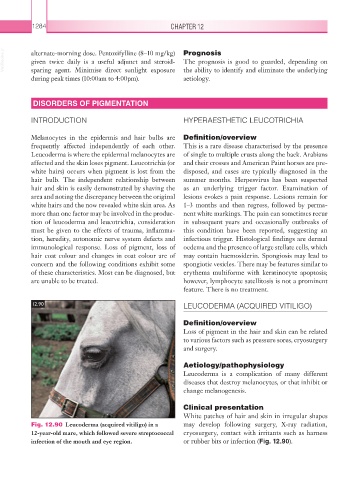Page 1309 - Equine Clinical Medicine, Surgery and Reproduction, 2nd Edition
P. 1309
1284 CHAPTER 12
VetBooks.ir alternate-morning dose. Pentoxifylline (8–10 mg/kg) Prognosis
The prognosis is good to guarded, depending on
given twice daily is a useful adjunct and steroid-
sparing agent. Minimise direct sunlight exposure
aetiology.
during peak times (10:00am to 4:00pm). the ability to identify and eliminate the underlying
DISORDERS OF PIGMENTATION
INTRODUCTION HYPERAESTHETIC LEUCOTRICHIA
Melanocytes in the epidermis and hair bulbs are Definition/overview
frequently affected independently of each other. This is a rare disease characterised by the presence
Leucoderma is where the epidermal melanocytes are of single to multiple crusts along the back. Arabians
affected and the skin loses pigment. Leucotrichia (or and their crosses and American Paint horses are pre-
white hairs) occurs when pigment is lost from the disposed, and cases are typically diagnosed in the
hair bulb. The independent relationship between summer months. Herpesvirus has been suspected
hair and skin is easily demonstrated by shaving the as an underlying trigger factor. Examination of
area and noting the discrepancy between the original lesions evokes a pain response. Lesions remain for
white hairs and the now revealed white skin area. As 1–3 months and then regress, followed by perma-
more than one factor may be involved in the produc- nent white markings. The pain can sometimes recur
tion of leucoderma and leucotrichia, consideration in subsequent years and occasionally outbreaks of
must be given to the effects of trauma, inflamma- this condition have been reported, suggesting an
tion, heredity, autonomic nerve system defects and infectious trigger. Histological findings are dermal
immunological response. Loss of pigment, loss of oedema and the presence of large stellate cells, which
hair coat colour and changes in coat colour are of may contain haemosiderin. Spongiosis may lead to
concern and the following conditions exhibit some spongiotic vesicles. There may be features similar to
of these characteristics. Most can be diagnosed, but erythema multiforme with keratinocyte apoptosis;
are unable to be treated. however, lymphocyte satellitosis is not a prominent
feature. There is no treatment.
12.90 LEUCODERMA (ACQUIRED VITILIGO)
Definition/overview
Loss of pigment in the hair and skin can be related
to various factors such as pressure sores, cryosurgery
and surgery.
Aetiology/pathophysiology
Leucoderma is a complication of many different
diseases that destroy melanocytes, or that inhibit or
change melanogenesis.
Clinical presentation
White patches of hair and skin in irregular shapes
Fig. 12.90 Leucoderma (acquired vitiligo) in a may develop following surgery, X-ray radiation,
12-year-old mare, which followed severe streptococcal cryosurgery, contact with irritants such as harness
infection of the mouth and eye region. or rubber bits or infection (Fig. 12.90).

